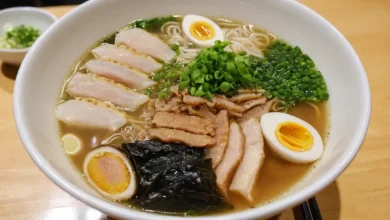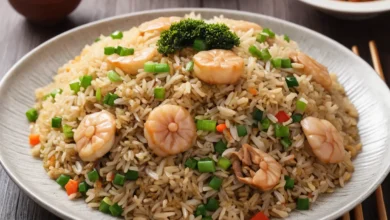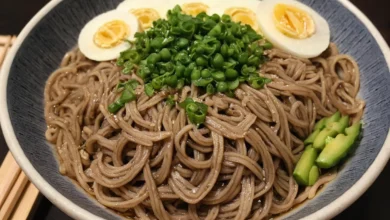Comfort in a Bowl: The Ultimate Guide to Making Doenjang Jjigae (Korean Soybean Paste Stew)

Doenjang Jjigae is a beloved Korean stew that represents comfort and home-cooked meals. With its rich, savory flavors derived from fermented soybean paste (doenjang), this dish is a staple in Korean households. Perfect for any season, Doenjang Jjigae is not just delicious but also packed with nutrients, making it a healthy option for any meal. In this blog, we will explore the origins of Doenjang Jjigae, essential ingredients, and a step-by-step guide to making this hearty stew at home. Whether you’re a seasoned cook or a novice in the kitchen, this recipe will guide you to create a perfect bowl of warmth and flavor.
Frequently Asked Questions About Doenjang Jjigae
- What is Doenjang Jjigae?
Doenjang Jjigae is a traditional Korean stew made primarily with doenjang (fermented soybean paste), vegetables, and sometimes tofu or meat. It’s known for its rich umami flavor. - Is Doenjang Jjigae healthy?
Yes! Doenjang is rich in protein, vitamins, and minerals, and the stew often includes a variety of vegetables, making it a nutritious meal option. - Can I make Doenjang Jjigae vegetarian?
Absolutely! You can easily omit any meat and add more vegetables or mushrooms to enhance flavor and texture. - What are the common ingredients used in Doenjang Jjigae?
Common ingredients include doenjang, tofu, zucchini, mushrooms, green onions, and potatoes, although you can customize it to your liking. - How can I store leftover Doenjang Jjigae?
Store leftovers in an airtight container in the refrigerator for up to 3 days. Reheat on the stove or in the microwave before serving.
Recipe: Traditional Doenjang Jjigae
Ingredients
- Base Ingredients:
- 3 tablespoons doenjang (fermented soybean paste)
- 4 cups water or vegetable broth
- Vegetables:
- 1 medium potato, diced
- 1 zucchini, sliced
- 1 cup mushrooms (shiitake or button), sliced
- 1 onion, sliced
- 2 green onions, chopped
- Protein:
- 200g firm tofu, cubed
- Optional: 100g beef or pork, sliced (for a non-vegetarian version)
- Seasonings:
- 1 tablespoon gochugaru (Korean red pepper flakes) – adjust to taste
- 1 teaspoon garlic, minced
- Salt and pepper to taste
- Garnish:
- Sesame oil for drizzling
- Extra chopped green onions
Instructions
- Prepare the Broth
In a pot, bring the water or vegetable broth to a boil. Stir in the doenjang, ensuring it dissolves completely into the liquid. This will form the base of your stew. - Add the Vegetables
Once the broth is boiling, add the diced potato, sliced zucchini, mushrooms, and onion. Allow the vegetables to simmer for about 10-15 minutes or until they become tender. - Add the Protein
If using meat, add it now and cook until it’s no longer pink. For vegetarian options, skip this step and proceed to the next. - Incorporate Tofu and Seasonings
Gently stir in the cubed tofu, minced garlic, gochugaru, and season with salt and pepper. Let the stew simmer for an additional 5-10 minutes, allowing the flavors to meld together. - Final Touches
Just before serving, add the chopped green onions and drizzle with a little sesame oil for added flavor. - Serve
Ladle the stew into bowls and serve hot, ideally with steamed rice and side dishes (banchan) for a complete Korean meal.
Tips for the Perfect Doenjang Jjigae
- Adjust the Consistency: If you prefer a thicker stew, let it simmer uncovered for a few extra minutes.
- Flavor Enhancements: Experiment with additional ingredients like kimchi, seafood, or other vegetables for unique variations.
- Freshness is Key: Use fresh, seasonal vegetables for the best flavor and texture.
- Serve with Rice: This stew pairs perfectly with a bowl of steamed rice to soak up the savory broth.
Variations of Doenjang Jjigae
1. Kimchi Doenjang Jjigae:
Add chopped kimchi to the stew for an extra layer of flavor and spice, making it perfect for those who love fermented foods.
2. Seafood Doenjang Jjigae:
Incorporate shrimp, clams, or squid for a delicious seafood twist that enhances the umami taste of the stew.
3. Spicy Doenjang Jjigae:
Increase the amount of gochugaru or add sliced fresh chili peppers for those who enjoy a bit of heat.
4. Mushroom Doenjang Jjigae:
Focus on various mushrooms like enoki, oyster, or shiitake to create a rich and earthy flavor profile.
Conclusion
Doenjang Jjigae is more than just a meal; it’s a comforting experience that warms the soul. With its savory broth and wholesome ingredients, this Korean soybean paste stew is a perfect representation of Korean home cooking. Whether enjoyed on a chilly evening or as a nourishing lunch, Doenjang Jjigae is sure to satisfy your cravings and bring a piece of Korea to your table. Try making this easy recipe at home, and experience the rich flavors and nutritional benefits of this beloved dish today!





